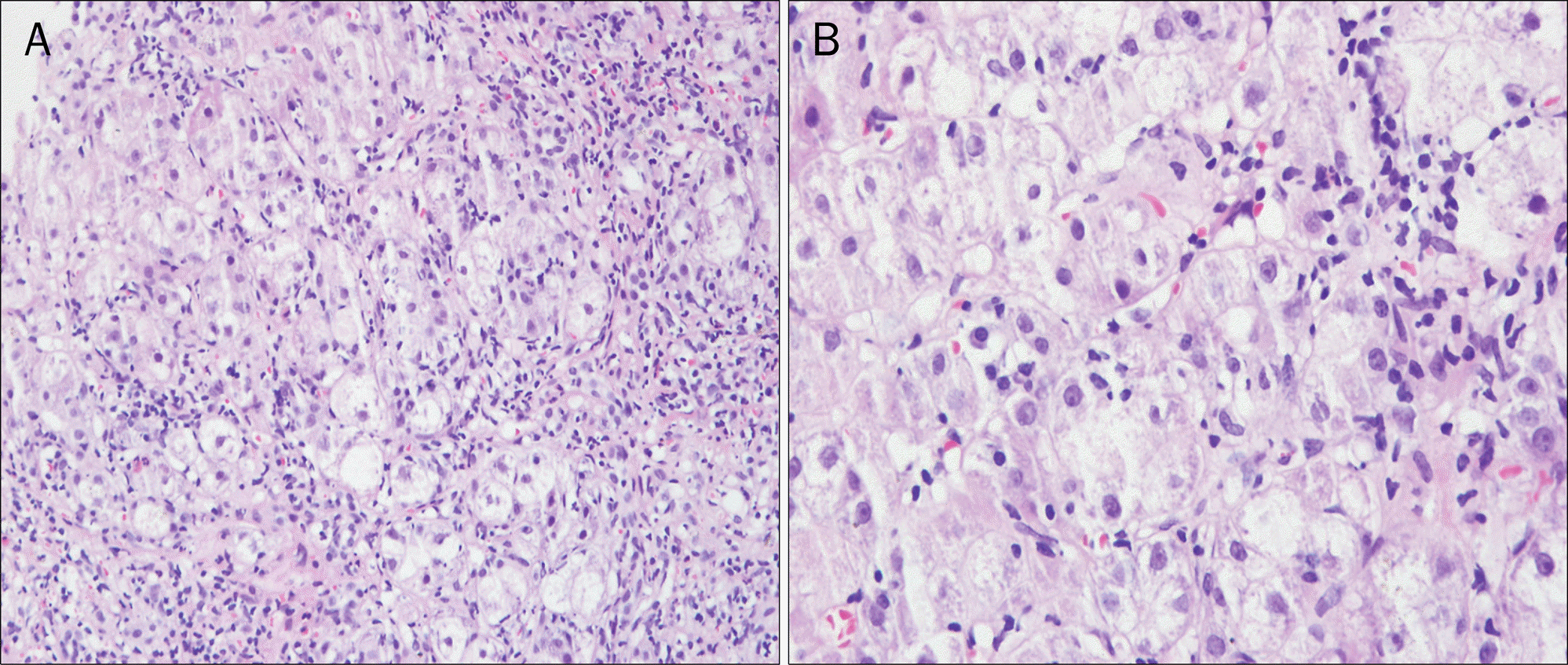Abstract
The pathogenesis of autoimmune hepatitis (AIH) is unclear, but viral infections have been proposed as a potential trigger in patients with genetic predisposition. We report a case of AIH following acute hepatitis A (AHA). A 57-year-old woman presented with fatigue and pitting edema for last 3 months. She had been diagnosed as an AHA 15 months ago based on clinical features, biochemical tests and positive HAV IgM antibody at a local clinic. Her biochemical tests was normalized one month after AHA diagnosis, but the serum levels of aminotransferase started to rise four months after AHA diagnosis. Antinuclear antibody was positive at a titer of 1:40, and anti-smooth muscle antibody was also positive. Hypergammaglobulinemia and liver pathology were typical for AIH. The patients had a score of 17 according to the International Autoimmune Hepatitis Group's system. She was given prednisolone and azathioprine and showed complete response to immunosuppressive therapy. The present case is the first report on AIH triggered by AHA in Korea.
Go to : 
References
1. Czaja AJ. Autoimmune hepatitis. Evolving concepts and treatment strategies. Dig Dis Sci. 1995; 40:435–456.
2. Vento S, Cainelli F. Is there a role for viruses in triggering autoimmune hepatitis? Autoimmun Rev. 2004; 3:61–69.

3. Vento S, Garofano T, Di Perri G, Dolci L, Concia E, Bassetti D. Identification of hepatitis A virus as a trigger for autoimmune chronic hepatitis type 1 in susceptible individuals. Lancet. 1991; 337:1183–1187.

4. Rahaman SM, Chira P, Koff RS. Idiopathic autoimmune chronic hepatitis triggered by hepatitis A. Am J Gastroenterol. 1994; 89:106–108.
5. Huppertz HI, Treichel U, Gassel AM, Jeschke R, Meyer zum Büschenfelde KH. Autoimmune hepatitis following hepatitis A virus infection. J Hepatol. 1995; 23:204–208.

6. Tanaka H, Tujioka H, Ueda H, Hamagami H, Kida Y, Ichinose M. Autoimmune hepatitis triggered by acute hepatitis A. World J Gastroenterol. 2005; 11:6069–6071.

7. Grünhage F, Spengler U, Fischer HP, Sauerbruch T. Autoimmune hepatitis–sequel of a relapsing hepatitis A in a 75-year-old woman. Digestion. 2004; 70:187–191.
8. Vento S, Guella L, Mirandola F, et al. Epstein-Barr virus as a trigger for autoimmune hepatitis in susceptible individuals. Lancet. 1995; 346:608–609.

9. Hyun JG, Paik SW, Lee JH, et al. Clinical features of autoimmune hepatitis in Korea. Korean J Gastroenterol. 1999; 33:653–661.
10. Lee YS. Autoimmune hepatitis: recent update on diagnosis and treatment. Korean J Hepatol. 2006; 12:318–332.
11. Vallbracht A, Maier K, Stierhof YD, Wiedmann KH, Flehmig B, Fleischer B. Liver-derived cytotoxic T cells in hepatitis A virus infection. J Infect Dis. 1989; 160:209–217.

12. Vento S, McFarlane BM, McSorley CG, et al. Liver autoreactivity in acute virus A, B and non-A, non-B hepatitis. J Clin Lab Immunol. 1988; 25:1–7.
Go to : 
 | Fig. 1.Pathologic findings of liver biopsy specimen. (A) Interface hepatitis with bridging fibrosis was observed (H&E stain, ×100). (B) Lympho-plasmacytic infiltration was also noted (H&E stain, ×400). |
Table 1.
Clinical Course of the Patient




 PDF
PDF ePub
ePub Citation
Citation Print
Print


 XML Download
XML Download